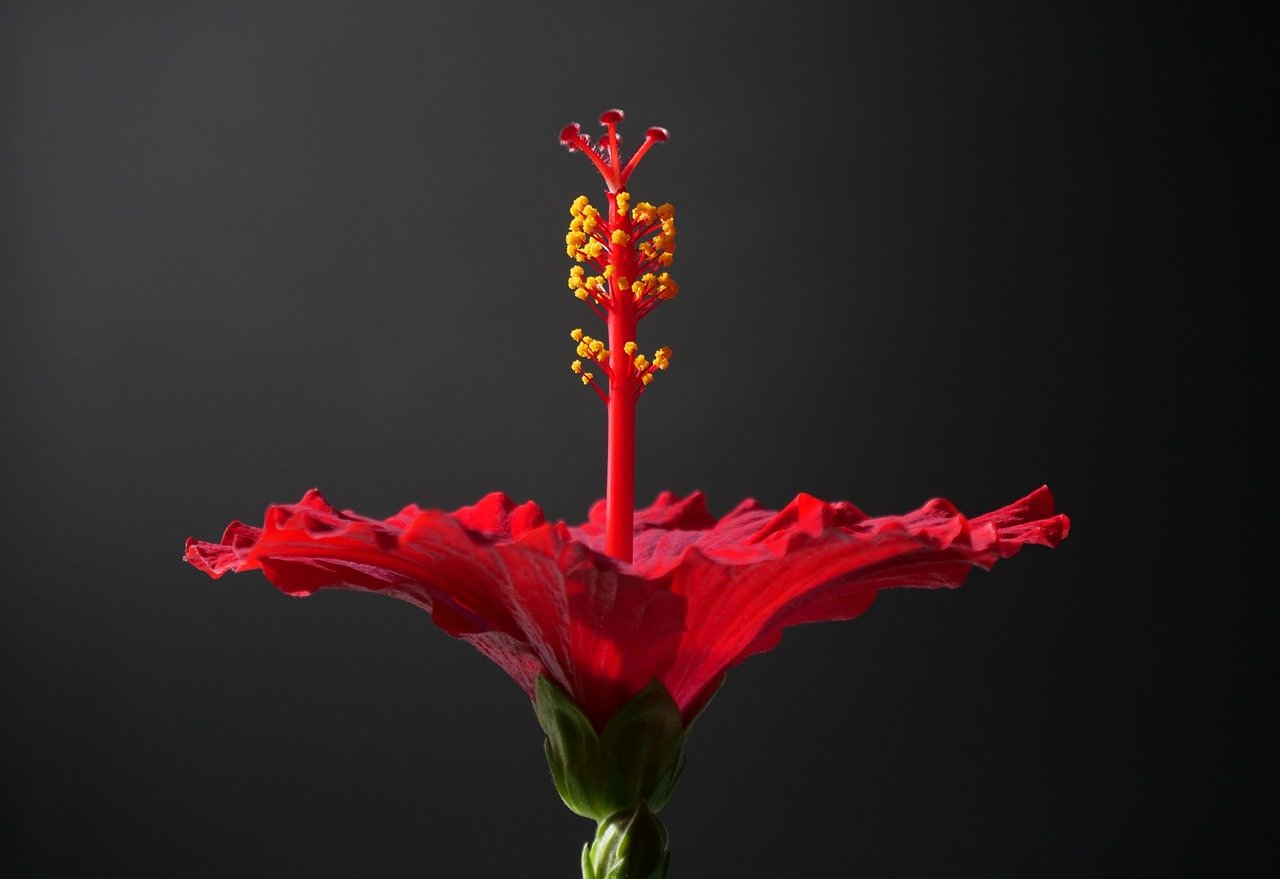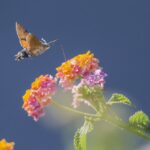Although hibiscus is commonly associated with tropical or subtropical regions, it also flourishes in temperate settings around the world. Hibiscus is a broad genus with over 200 species and several cultivars, including annuals, perennials, shrubs, and small trees.
All hibiscus have huge, trumpet-shaped flowers that can grow up to 12 inches in diameter; they are the major attraction of this popular ornamental plant.

The blooms come in a variety of brilliant colors, including white, pink, red, blue, orange, peach, yellow, and purple. All hibiscus flowers are particularly appealing to butterflies and hummingbirds.
Care and growing requirements differ per species, so make sure you understand the details of the hibiscus you have.
| Common Name | Hibiscus |
| Botanical Name | Hibiscus spp. |
| Family | Malvaceae |
| Plant Type | Perennial, annual, herbaceous, shrub |
| Mature Size | 3-10 ft. tall, 2-8 ft. wide |
| Sun Exposure | Full, partial |
| Soil Type | Moist but well-drained |
| Soil pH | Acidic, neutral |
| Bloom Time | Summer, fall |
| Flower Color | red, pink, White, yellow, purple orange, |
| Hardiness Zones | 4-11 (USDA) |
| Native Area | Asia, North America |
Hibiscus Care
The care you provide your hibiscus will differ based on whether it is a hardy or tropical kind, and whether it is grown indoors or outside. Here are the primary care requirements for cultivating hibiscus:
In northern climates, plant hibiscus in full sunlight. In the south, filtered sunlight is preferred.

The soil should be rich and loamy. All hibiscus require continually moist soil with adequate drainage. Keep the soil moist, and water as needed.
Choose kinds that can withstand the temperatures in your area year-round. Alternatively, hibiscus can be grown in pots and overwintered indoors.Hibiscus should be pruned in the spring, when the temperature heats up.
Light
Hibiscus prefers light conditions. Full sun is ideal in northern climates, although filtered sunlight is preferable in southern climates.
Indoors, hibiscus need a bright position near a sunny window. However, keep it out of bright, direct sunlight. If you take the plant outside for the summer, gradually adjust it to the brighter lighting conditions.
Soil
All hibiscus grow best in well-drained, fertile, wet, loam soil. The hardy forms are wetland natives and are ideal for locations where other plants cannot thrive. Most hibiscus prefer somewhat acidic soil pH.
Water
All hibiscus are thirsty plants that require moisture. Unless they are planted in continuously moist soil, water them on a frequent basis. Mulching around the plant base promotes moisture retention.

Before watering container-grown plants, ensure that the top inch of the potting mix is completely dry. In warmer summer months, you may need to water your potted hibiscus as frequently as daily.
Indoor tropical hibiscus grows best when watered on a regular basis from spring to early autumn. Watering should be reduced significantly during the winter dormancy period.
Temperature & Humidity
Temperature tolerance varies by species.
Hardy hibiscus thrives in cool, temperate areas. It thrives in temperatures ranging from 60 to 90 degrees Fahrenheit and can withstand temperatures as low as -30 degrees Fahrenheit.2
Temperatures below 50 degrees Fahrenheit cause cold-sensitive and tropical kinds to lose their leaves, while temperatures below freezing kill them. Bring container-grown tropical hibiscus indoors when the weather cools.
All hibiscus thrive in high humidity and are not ideal for hot, arid areas. The high humidity found in a bathroom is ideal for an indoor hibiscus.
Fertilizer
Hibiscus requires modest but consistent fertilization to produce prolific, robust flowers in brilliant colors. There is a particularly developed hibiscus fertilizer, but any other fertilizer with moderate nitrogen, low phosphorus, and high potassium, such as 10-4-12 or 12-4-18, would suffice.
For hardy or tropical hibiscus, apply a diluted, water-soluble fertilizer once a week. Granular slow-release fertilizer should be used to hardy hibiscus three times a year, in early spring, after the first cycle of blooming, and in July, while tropical hibiscus should be fertilized monthly from spring to fall.
Types of Hibiscus
There are hundreds of hibiscus species, including both tropical and hardy varieties, as well as several hybrids and cultivars. The four most popular species include:
Tropical hibiscus (Hibiscus rosa-sinensis):
Tropical hibiscus plants, also known as Chinese hibiscus, produce huge and beautiful blooms from spring to fall, as long as they receive plenty of sunlight.
In colder climates, grow tropical hibiscus in a pot and keep it indoors for the winter. There are numerous types available, including the famous ‘Fiesta’, which has glossy dark green foliage and vivid orange blooms with crinkled edges. USDA Hardiness Zone 7–11.
Hardy hibiscus
This is the hibiscus for chilly weather. Native to North America, the large flowers have tissue-thin, ruffled petals in pink, lilac, crimson, magenta, and white. ‘Perfect Storm’ is a hardy, compact hybrid cultivar that blooms later in the season. USDA Hardiness Zone 4–9.
Swamp hibiscus
This uncommon hibiscus species, native to the southeastern United States, produces huge, bright red, pinwheel-shaped flowers in the summer. USDA Hardiness Zone 6-9
Cotton rose
This tropical shrub’s stunning blossoms begin as white or light pink and progress to magenta pink, dark pink, and red within one to three days. USDA Hardiness Zone 7–11.
Pruning
Annual pruning of hibiscus fosters new growth with bloom buds. The timing varies depending on the type of hibiscus you have, but pruning should begin as soon as the weather warms up in the spring.
Hardy hibiscus falls back to the ground in the winter, so you only need to remove the dead stems before new growth starts. Dead, damaged, or diseased stems should be pruned as soon as they become visible.
Propagating Hibiscus
Some hibiscus varieties are best propagated through stem cuttings, while others can be grown from seed. Follow the step-by-step propagation instructions for the hibiscus you have.
How To Grow Hibiscus From Seeds
Growing hibiscus from seeds is typically recommended mainly for swamp hibiscus and roselle (Hibiscus sabdariffa), the hibiscus species whose blossoms are used in tea.
For all other hibiscus kinds, propagation from seed is not only difficult, but it can also yield unsatisfactory results because hibiscus cultivars and hybrids produced from seed will not produce
Potting and Repotting Hibiscus
Potted hibiscus that thrive on nutrients should be repotted every couple of years in early spring. Avoid deep pots; otherwise, the plant will devote a lot of its energy to root development rather than bloom production. The optimum pot design is wide but rather shallow.
Repot a plant that has outgrown its container into a pot that is one size larger and filled with new potting mix. Water well to help the settle into its new home.
Overwintering
Tropical hibiscus is only hardy to USDA Zone 9, thus it must be overwintered inside in a warm location with lots of indirect sunlight everyday.
Before moving the plant inside, cut it back by one-third and thoroughly spray it with a garden hose to get rid of any bugs.
Allow the soil to nearly completely dry out between waterings and discontinue fertilization. Leaf drop during dormancy is typical; the plant will resume growth in the spring.
Common Pests & Plant Diseases
Hibiscus is not plagued by many pests or illnesses, but red spider mites might be an issue if humidity levels are too low. Aphids are another potential pest. Keep them at bay by cleaning on a regular basis or using insecticide soaps.
How to get Hibiscus to bloom
Bloom Months
Hibiscus flowers range from June to early September, depending on the variety.
How Long Does Hibiscus Bloom?
Individual flowers in most types endure only one day before closing and falling off the plant. The payoff is a lengthy bloom time. Hardy hibiscus blooms from mid- to late summer until the first frost, while tropical hibiscus blooms from spring to late fall, and even into winter in frost-free areas.
Common Problems With Hibiscus
Hibiscus is not difficult to grow, but there are a few frequent issues to watch out for.
Yellow Foliage
If you notice your plant’s leaves becoming yellow, it could be because you are exposing it to rapid changes in weather, not watering properly, or not feeding frequently enough. Expect some yellowing during the transitional seasons of spring and fall, but anything excessive warrants additional inquiry.
Dropping of Buds
Extreme temperatures, insufficient light or humidity, and overwatering or underwatering can all induce bud loss.








